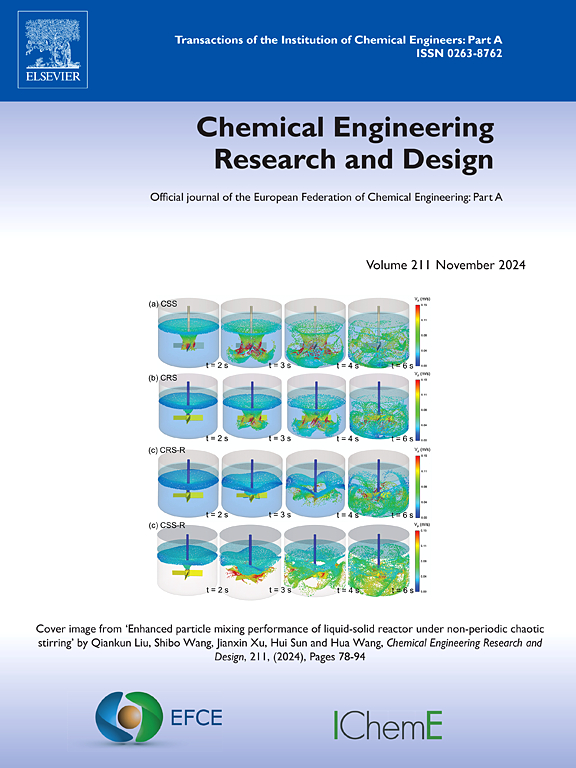Simulation study of heat transfer and cooling enhancement measures for slag particles in granulation chamber
IF 3.7
3区 工程技术
Q2 ENGINEERING, CHEMICAL
引用次数: 0
Abstract
The steel industry, being one of the major contributors to global energy consumption and environmental pollution, has drawn significant attention to the management of its by-products, especially the treatment of blast furnace slag and the recovery of waste heat. Centrifugal granulation and waste heat recovery technology are considered the most promising solutions. However, their development is constrained by the limited heat exchange space within the granulation chamber, resulting in insufficient cooling rates for the granulated particles. This ultimately threatens the safe operation of the system. In this study, we established a heat exchange model for a granulation chamber that integrates various structures and enhanced cooling measures, investigating the flight heat exchange characteristics of particles within the chamber. The results indicate that setting the granulation chamber wall angle to 0° and maximizing the granulator height within the limited space can extend the impact time of slag particles by more than 0.2 s. Positioning the air outlet at the center and limiting its width to within 200 mm increases air flow resistance, further reducing the slag particle outlet temperature by 15 K. Side and edge winds increase the solid phase fraction of particles at exit by 20 % and 6 %, also reduces the impact wall temperature by 9.56°C and 3.37°C,demonstrating the significant advantages of enhanced cooling measures. This study provides guidelines and standards for the structural design of granulation chambers in industrial applications and offers a new perspective on enhanced cooling measures to prevent wall adhesion.
渣粒造粒室传热强化冷却措施的模拟研究
钢铁工业是全球能源消耗和环境污染的主要来源之一,其副产品的管理,特别是高炉炉渣的处理和废热的回收,已引起人们的高度重视。离心造粒和余热回收技术被认为是最有前途的解决方案。然而,它们的发展受到制粒室内有限的热交换空间的限制,导致制粒颗粒的冷却速率不足。这最终会威胁到系统的安全运行。在这项研究中,我们建立了一个整合了多种结构和强化冷却措施的造粒室的换热模型,研究了颗粒在室内的飞行换热特性。结果表明:将制粒室壁角设置为0°,在有限空间内最大化制粒高度,可使渣粒的冲击时间延长0.2 s以上。将出风口定位在中心位置,并将其宽度限制在200 mm以内,增加了气流阻力,进一步降低了渣粒出口温度15 K。侧风和边风使出口颗粒固相分数分别提高了20 %和6 %,并使冲击壁温度分别降低了9.56°C和3.37°C,表明强化冷却措施的显著优势。该研究为工业应用中造粒室的结构设计提供了指导和标准,并为加强冷却措施以防止壁粘连提供了新的视角。
本文章由计算机程序翻译,如有差异,请以英文原文为准。
求助全文
约1分钟内获得全文
求助全文
来源期刊

Chemical Engineering Research & Design
工程技术-工程:化工
CiteScore
6.10
自引率
7.70%
发文量
623
审稿时长
42 days
期刊介绍:
ChERD aims to be the principal international journal for publication of high quality, original papers in chemical engineering.
Papers showing how research results can be used in chemical engineering design, and accounts of experimental or theoretical research work bringing new perspectives to established principles, highlighting unsolved problems or indicating directions for future research, are particularly welcome. Contributions that deal with new developments in plant or processes and that can be given quantitative expression are encouraged. The journal is especially interested in papers that extend the boundaries of traditional chemical engineering.
 求助内容:
求助内容: 应助结果提醒方式:
应助结果提醒方式:


